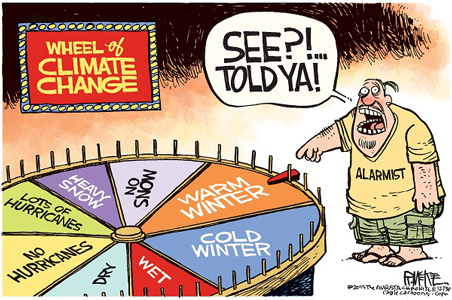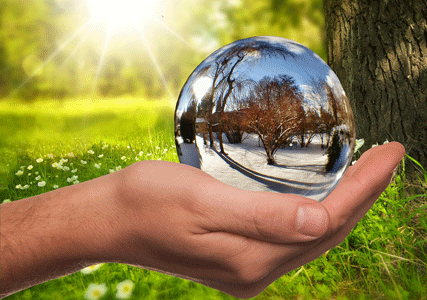
Steven E. Koonin (2021, p. 178):
I get the distinct sense that the science is unsettled enough that any unusual weather can be "attributed" to human influences.
Attributie-studies

Steven E. Koonin (2021, p. 178):
I get the distinct sense that the science is unsettled enough that any unusual weather can be "attributed" to human influences.
U bent hier: inhoudsopgave - atmosfeer en klimaat - attributiestudies
Afkorting of begrip onbekend ? Raadpleeg ons milieuwoordenboek !
Follow@plattezaken en Facebook of Linkedin
Attributiestudies
Nu het klimaat nauwelijks of niet meer opwarmt en het steeds moeilijker blijkt om aan te tonen dat CO2-toename meer extreem weer veroorzaakt dan vroeger, is er onder klimaat-alarmistische onderzoekers een nieuwe tak van "sport" ontstaan: Attributie-studies. Dat gebeurt o.a. in de Onderzoeksgroep World Weather Attribution. zie het NOS-artikel van 11 mei 2022 van de hand van Heleen Ekker: Klimaatwetenschappers: elke hittegolf heeft nu link met klimaatverandering, NOS-nieuws, 11-5-2022
Bij elke vorm van slecht weer laten ze hun computers ratelen met hun modellen, waar dan - vaak al binnen enkele dagen - uitkomt dat dit slechte weer nu extra frequent voorkomt dankzij de menselijke uitstoot van CO2, die toch wel een ernstige vorm van klimaatverandering zou veroorzaken.
Ze geloven in de wetenschappelijkheid van hun werk. Zoals Friederike Otto stelt: “In this way we are able to move from anecdote and conjecture, from superstition and wishful thinking, to science. We have evidence and we have facts. They are a secure foundation for news”. Friederike Otto is dan ook een van de leidende personen bij de WWA-World Weather Attribution. Ook is ze betrokken geweest bij het opstellen van de WWA-gids voor journalisten getiteld "Reporting extreme weather and climate change".
Peter Siegmund van het KNMI denkt er anders over: "Dat zo veel landen te maken kregen met hetzij extreme hitte, dan wel extreme regenval, is volgens de KNMI-onderzoeker Peter Siegmund toeval: ‘De atmosfeer heeft een geheugen van twee weken, zou je kunnen zeggen. Dus extremen die verder uit elkaar liggen, hebben geen verband met elkaar."
(bron: KNMI-onderzoeker Peter Siegmund: extreme hitte of regenval is toeval, Climategate.nl, 3-9-2023
Chris Morrison maakt gehakt van deze nieuwe tak van "klimaat-wetenschap-sport":
It is simple to explain what ‘attribution’ models do. First they simulate a climate with no human involvement that does not exist, and then compare it with another simulation that is supposed to reflect the involvement of humans burning fossil fuel.
Any weather event at a local level that is magnified in the second is, abracadabra, said to be due to human-caused climate change.
To take such results seriously it must be assumed that the models have correct information in the first place. An inability over 40 years for climate models to predict an accurate temperature would seem to indicate they are work in progress.
Ignorance of the equilibrium climate sensitivity (ECS) number – the amount the Earth will warm if carbon dioxide is doubled in the atmosphere – would be considered another handicap.
In addition, it is interesting to observe some academics attempting to produce a perfect model capable of such precision when they are mapping a climate system that is non-linear with numerous, only partially understood, powerful forces at work.
How anyone can take the results seriously, with all the inevitable ‘garbage in-garbage out’ possibilities, is a mystery. Measuring cats in a sack might be considered a marginally easier task. |
Francis Menton (2021) beschrijft attributiestudies als volgt:
All attribution studies work around the same basic theme. . . . A model of the climate as it does not exist, but which is claimed to represent what the climate would look like had mankind not ‘interfered’ with it, is run many times. The outputs from these runs are examined for some ‘bad’ or ‘extreme’ event, such as higher temperatures or increased numbers of hurricanes making landfall, or rainfall exceeding some amount. The frequency with which these bad events occur in the model is noted. Next, a model of the climate as it is said to now exist is run many times. This model represents global warming. The frequencies from the same bad events in the model are again noted. The frequencies between the models are then compared. If the model of the current climate has a greater frequency of the bad event than the imaginary (called ‘counterfactual’) climate, the event is said to be caused by global warming, in whole or in part.
In other words, the “attribution” study consists of invalidating a null hypothesis that is itself a counterfactual model with no demonstrated connection to the real world as it would have existed in the absence of human influences.
The people who create these counterfactual models can of course build into them any characteristics they want in order that the result of their study will come out to be an “attribution” of the real-world data to human influences. Why anyone would give any credence to any of this is beyond me.
 |
Attribution studies fail the falsification principle outlined by the science philosopher Karl Popper. This is held to be the test that differentiates real science from pseudoscience. Any hypothesis must be testable and conceivably proved false. Unless a suggestion can be tested in this way, it is opinion, guesswork, or, more uncharitably, crystal ball-gazing. |
Stating, for instance, that a bad storm was caused by humans when a natural explanation is also available, or calculating that wildfires will consume so many more acres than before, is unprovable. It therefore fails the test to be termed science.
Morrison concludeert: "Science? Unverified guesswork would be more accurate. Popper must be turning in his grave.
De WWA-gids voor journalisten om over extreem weer te rapporteren voorziet in een behoefte hieraan bij de pers, die al in 1871 opviel;
|
Sinds jaar en dag zien velen in een paar jaren extreem weer, of zelfs bij heel wat kortere periodes extreem weer, al gauw, maar ten onrechte, een klimaatverandering optreden, even vergetend dat klimaat meestal wordt gedefinieerd als het gemiddelde weer over een periode van minstens 30 jaren. In 1871 wordt daar al over geklaagd door een lezer van de krant The Brisbane Courier !
Klik op de tekst voor een vergroting ------------------------>
|
The UN IPCC’s latest report, known as “Assessment Report 6” or “AR6,” came out in early August loaded up, as already noted, with one statement after another about “high confidence” in the attribution of climate changes and disasters to human influences.
In the couple of months since, a few statisticians who actually know what they are doing have responded. On August 10, right on the heels of the IPCC, Ross McKitrick — an economist and statistician at the University of Guelph in Canada — came out with a paper in Climate Dynamics titled “Checking for model consistency in optimal fingerprinting: a comment.”
On October 22, the Global Warming Policy Foundation then published two Reports on the same topic, the first by McKitrick titled “Suboptimal Fingerprinting?”, and the second by statistician William Briggs titled “How the IPCC Sees What Isn’t There.
But both McKitrick and Briggs’s October papers are accessible to the layman. And in any event, the fundamental flaw of all of the IPCC’s efforts at claimed “attribution” is not difficult to understand.
Conclusies
Verschil met vroeger is vooral dat de huidige "klimaatwetenschappers" hun diagnoses baseren op een hele hoop zelf verzonnen en geselecteerde klimaatvariabelen met zelf verzonnen weegfactoren in zelf verzonnen computerprogramma's die het klimaat zouden kunnen beschrijven (qoud non). Het lijkt wetenschappelijk, maar het is niet beter dan het kermiskraampje waarin een dame met kristallen bol.
De betrokken wetenschappers zijn de hedendaagse verschijningsvorm van de vroegere priesters: zij zeggen wat goed en kwaad is, wat ons in de toekomst te wachten staat en wat er voor verschrikkelijks gaat gebeuren als we niet doen wat ze zeggen en offerandes brengen aan de nieuwe weergoden.
Literatuur:
-
Ekker, Heleen, Klimaatwetenschappers: elke hittegolf heeft nu link met klimaatverandering, NOS-nieuws, 11-5-2022
- Morrison, Chris, As the Climate Refuses to Break Down on Cue, the Pseudoscience of ‘Attribution Studies’ Rises Up to Plug the Holes, The Daily Sceptic, 15-10-2022
- Menton, Francis, Attribution studies have turned climate science into a clown show, Climate Change Dispatch, 29-10-2021.
- Joel Zeder, Sebastian Sippel, Olivier C. Pasche, Sebastian Engelke, Erich M. Fischer, The Effect of a Short Observational Record on the Statistics of Temperature Extremes, Geophysical Research Letters, 25-8-2023
- Wieliki, Matthew, Climate Change Attribution: The Quest For Truth Amidst The Chaos, ClimateChangeDispatch, 21-3-2024
U bent hier: inhoudsopgave - atmosfeer en klimaat - attributiestudies
zie ook onze webpagina over extreem weer.
Deze website is een activiteit van dr. Hugo H. van der Molen, Copyright 2007 e.v.
Mail ons uw commentaar, aanvullingenen en correcties !
Follow @plattezaken en Facebook of Linkedin